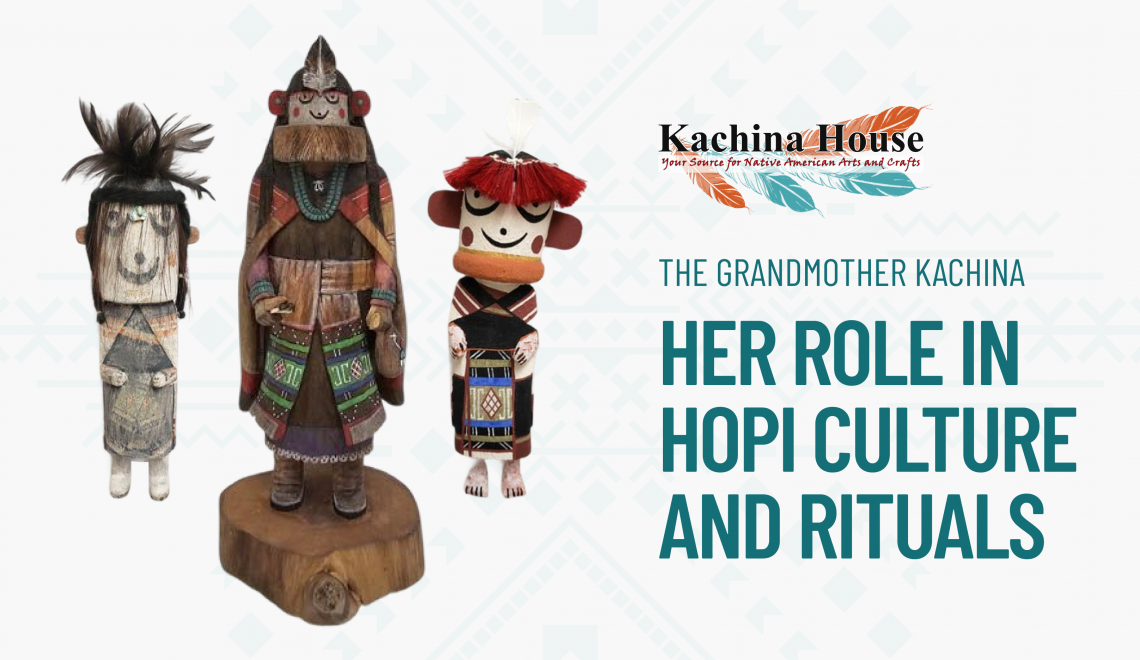
Are you curious about the spiritual significance behind one of the most revered figures in Pueblo culture? The Grandmother Kachina, known as Hahay-i wu-uti, or “pour water woman,” represents far more than artistic craftsmanship. She embodies centuries of Hopi wisdom, maternal protection, and life-sustaining power.
Whether you’re a collector of authentic Native American art or seeking deeper meanings behind traditional Kachina dolls, this guide reveals the symbolism of this cherished figure.
You’ll discover:
- The sacred symbolism behind the Grandmother Kachina
- How to identify authentic Grandmother Kachina dolls
- Her crucial role in Pueblo ceremonies
The Sacred Identity of Hahay-i Wu-uti
The Grandmother Kachina holds an elevated position within the Hopi spiritual hierarchy. Her name translates to “pour water woman,” revealing her essential role as a life-giver and one who sustains of all living things.
Native American cultures treat elders with profound respect, holding them as wise souls and essential keepers of tribal knowledge. The Grandmother Kachina represents this reverence magnified to a spiritual level. She shares the title “Mother of all Katsinam” with Crow Mother Kachina.
As wife of Eototo, the chief of all Kachinas, she provides crucial feminine balance to his masculine leadership. This partnership demonstrates the Hopi understanding that both male and female energies are necessary for cosmic harmony.
What Does the Grandmother Kachina Symbolize?
Let’s examine the interconnected meanings Grandmother embodies:
Life-Giving Water and Nourishment
The most prominent symbol is water. In traditional depictions, she carries water in a gourd, symbolizing the essential flow of life. For desert-dwelling Pueblo communities, water represents survival, growth, and spiritual cleansing.
In her other hand, she holds an ear of corn, symbolizing nourishment. Corn holds sacred significance in Native American culture, representing sustenance and the cycle of life from planting to harvest.
Maternal Wisdom and Authority
The Grandmother Kachina embodies wisdom accumulated with age and experience. Her maternal nature includes both nurturing care and firm discipline. She exercises strict authority over her children, the Nataskas (monster Kachinas), demonstrating that true maternal love encompasses protection and guidance.
Her Role in Hopi Ceremonies
The Grandmother Kachina participates in crucial ceremonies, each appearance reinforcing different aspects of her nature.
Water Serpent Ceremony
She serves as the main participant, where she is notable for speaking frequently in a loud, high-pitched voice. This vocal characteristic has remained consistent across generations.
Bean Dance (Powamuya)
In this ceremony, she appears with varying purposes:
- Testing Generosity: She sometimes demands to be fed by villagers, testing their respect
- Providing Blessings: Other times, she provides food to children and blesses them with water
These roles reinforce the reciprocal relationship between humans and the natural world.
How to Identify the Grandmother Kachina Doll
Recognizing authentic Grandmother Kachina dolls requires attention to specific visual elements:
Distinctive Physical Features
- Facial Appearance: Shows a woman with red rosy cheeks and a loving smile
- Traditional Dress: Wears customary Hopi women’s clothing, including manta (traditional dress)
- Natural Materials: Carved from cottonwood root and painted with natural pigments
Sacred Objects and Symbols
Aside from her facial features, her most identifying characteristics are her ceremonial objects:
- Water Gourd: A vessel in one hand that is painted with Hopi rain clouds
- Corn: An ear of corn in the other hand, representing nourishment, the gift of Mother Earth
- Traditional Colors: Earth tones reflecting her connection to Mother Earth
Cultural Significance in Child Rearing
The Grandmother Kachina plays a crucial role in Hopi cultural transmission. All Hopi infants receive a flat-form Grandmother Kachina doll (tihu) at birth, introducing them to their spiritual heritage from the earliest age. This Kachina remains with the baby throughout its first year of life.
Throughout their childhood female children are gifted various Kachinas at ceremonies. These Kachinas are used as teaching tools, to educate the young girls about the Kachina’s characteristics. These Kachinas also serve to protect and guide the children as they mature.
Preserving Sacred Traditions
While parts of Hopi ceremonial life have evolved, the Grandmother Kachina remains vital in contemporary spiritual practice. Modern Hopi and Pueblo carvers continue creating representations, maintaining traditional techniques while incorporating contemporary artistic interpretations.
These dolls serve as educational tools for teaching tribal history, allowing artistic expression while maintaining traditional craftsmanship, and as cultural bridges helping audiences understand indigenous beliefs.
The Enduring Legacy
The Grandmother Kachina’s significance demonstrates the resilience of indigenous spiritual traditions. She embodies fundamental Hopi values about intergenerational relationships, the sacred nature of water and agriculture, and the balance between nurturing care and guidance.
Discover Authentic Grandmother Kachina Dolls
Ready to explore authentic Kachina dolls? Visit KachinaHouse.com to discover our curated collection of traditional and contemporary Kachina figures, including exquisite Grandmother Kachina representations. Our selection honors master carvers’ traditions while providing meaningful cultural representations for collectors.

